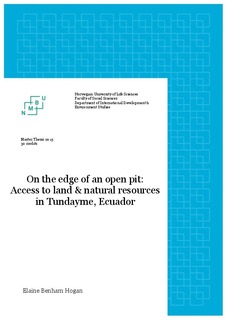| dc.contributor.author | Hogan, Elaine Benham | |
| dc.date.accessioned | 2016-03-31T11:04:33Z | |
| dc.date.available | 2016-03-31T11:04:33Z | |
| dc.date.issued | 2016-03-31 | |
| dc.identifier.uri | http://hdl.handle.net/11250/2383362 | |
| dc.description.abstract | This research will explore how the presence of the Mirador open pit copper mine has altered access to land and natural resources in Tundayme, Ecuador. The mine is located in southern part of the country along the border of Peru in a rural region of the Ecuadorian Amazon known for its exceptional biodiversity. Ecuador's economy is heavily dependent upon income from petroleum extraction but the present administration plans to significantly increase mineral extraction. The Mirador project is slated to become the nation's first large-scale open pit mine. Extensive changes to mining laws have been made in order for the state to accumulate more revenue from extraction. Mirador is one of five strategic mines that will be exploited in order to foster national development.
Tundayme is home to the indigenous Shuar who had little contact with mestizo settlers from other areas of Ecuador until the 1950s. Similarly, they were never conquered by the Inca or Spanish. Large-scale, open pit mining represents a significant change in land use from traditional farming and subsistence practices of the Shuar and mestizo populations. Processes of land acquisition for the mine have been irregular and marked changes in water quality have been observed during the initial construction phase.
Qualitative methods of observation and interviewing were used to explore residents' experiences related to environmental change and access to natural resources. Identified factors affecting access include direct accumulation of land andnatural resources, as well as dispossession by contamination from perceived mining pollution. Ribot & Peluso's theory of access framework is used to identify a variety of broader mechanisms affecting access and obtain a comprehensive view of the complex local context.Local responses to the mine's direct appropriation of land and natural resources are examined. Growing concerns of dispossession due to contamination from the mine are explored by examining people's perceptions of environmental change and their adaptations. | nb_NO |
| dc.language.iso | eng | nb_NO |
| dc.publisher | Norwegian University of Life Sciences, Ås | |
| dc.rights | Navngivelse 3.0 Norge | * |
| dc.rights | Navngivelse 3.0 Norge | * |
| dc.rights.uri | http://creativecommons.org/licenses/by/3.0/no/ | * |
| dc.subject | Mining | nb_NO |
| dc.subject | Ecuador | nb_NO |
| dc.subject | Development | nb_NO |
| dc.subject | Shuar | nb_NO |
| dc.subject | Mirador | nb_NO |
| dc.subject | Land | nb_NO |
| dc.subject | Access | nb_NO |
| dc.subject | Natural Resources | nb_NO |
| dc.title | On the edge of an open pit : access to land & natural resources in Tundayme, Ecuador | nb_NO |
| dc.type | Master thesis | nb_NO |
| dc.subject.nsi | VDP::Social science: 200 | nb_NO |
| dc.subject.nsi | VDP::Agriculture and fishery disciplines: 900::Agriculture disciplines: 910::Management of natural resources: 914 | nb_NO |
| dc.source.pagenumber | 78 | nb_NO |
| dc.description.localcode | M-IDS | nb_NO |

